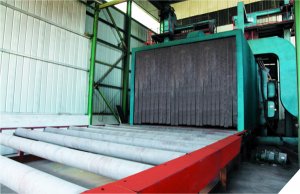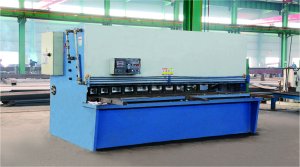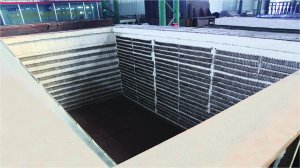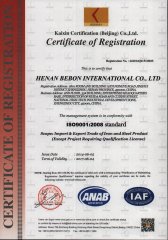Mining steel stands as the backbone of extractive industries, providing the essential strength and durability needed to withstand the harsh conditions of mining operations. From underground tunnels to surface excavations, mining steel plays a vital role in equipment, infrastructure, and safety measures, ensuring the efficient extraction of precious resources from the earth.
Mining steel is renowned for its exceptional strength and toughness, capable of withstanding heavy loads, impacts, and abrasive wear encountered in mining operations. Its robustness ensures the structural integrity of equipment and infrastructure, minimizing downtime and maintenance costs associated with mechanical failures.Mining steel exhibits superior abrasion resistance, making it well-suited for applications where equipment is subjected to abrasive wear from rocks, ores, and other abrasive materials. Hardened steel alloys, such as manganese steel and AR (Abrasion Resistant) steel, are commonly used in mining equipment components such as buckets, liners, and crushers to withstand abrasive forces.In addition to abrasion resistance, mining steel must also possess adequate corrosion resistance to withstand exposure to moisture, chemicals, and corrosive environments prevalent in mining operations. Stainless steel and corrosion-resistant alloys are employed in equipment and structures exposed to acidic or alkaline solutions, corrosive gases, and saline conditions to prevent degradation and prolong service life.Weldability and formability are essential characteristics of mining steel, enabling the fabrication of complex structures, components, and assemblies used in mining equipment and infrastructure. Weldable steel grades allow for the construction of welded joints and assemblies, while formable steel alloys facilitate the shaping and machining of parts to meet specific design requirements.
Mining steel is extensively used in the construction of heavy-duty equipment components such as buckets, blades, teeth, and drill bits. Hardened steel alloys, including manganese steel (Hadfield steel) and high-carbon steel, provide the necessary strength, abrasion resistance, and impact toughness to withstand the rigors of excavation, loading, and material handling in mining operations.Mining steel forms the backbone of structural support systems in underground mines, including roof supports, tunnel linings, and reinforcement elements. Steel beams, columns, and mesh systems provide structural stability and safety for miners working in underground environments, mitigating the risk of collapses, rockfalls, and ground instability.Steel is integral to the construction of processing plant components such as crushers, mills, conveyors, and screens used in mineral processing and beneficiation operations. Stainless steel and wear-resistant alloys are employed in equipment exposed to abrasive slurries, corrosive chemicals, and high-temperature processing conditions to ensure reliable performance and longevity.Mining steel is utilized in the construction of transportation and logistics infrastructure for the movement of raw materials, equipment, and personnel within mining sites. Steel rail tracks, bridges, gantry cranes, and storage facilities facilitate the efficient transport and handling of bulk materials, machinery, and supplies, supporting the logistics chain of mining operations.
Despite their inherent abrasion resistance, mining steel components are subject to wear and degradation over time due to the abrasive nature of mining processes. Continuous exposure to abrasive materials such as rocks, ores, and minerals can lead to wear, erosion, and material loss, necessitating regular maintenance, repair, and replacement of worn components.Corrosion is a common challenge faced by mining steel in environments with high moisture, acidity, or salinity, such as underground mines, coastal areas, and chemical processing plants. Corrosion-resistant coatings, cathodic protection systems, and proper material selection are essential strategies for mitigating corrosion and extending the service life of mining equipment and infrastructure.Mining steel components are subjected to heavy loads, dynamic forces, and impact stresses during mining operations, leading to fatigue, deformation, and structural failures. Proper design, material selection, and engineering controls are necessary to ensure the structural integrity and safety of equipment under dynamic loading conditions, reducing the risk of catastrophic failures and accidents.Balancing operational efficiency with cost management is a key consideration in the selection and use of mining steel in equipment and infrastructure. While high-performance alloys offer superior durability and reliability, they may come at a higher initial cost compared to conventional materials. Lifecycle cost analysis, maintenance planning, and risk assessment are essential for optimizing the economic performance and reliability of mining operations.
Ongoing research and development efforts focus on advancing the properties and performance of mining steel through the development of advanced materials and alloys. Innovations in metallurgy, alloy design, and processing techniques aim to enhance the strength, abrasion resistance, and corrosion resistance of mining steel, enabling the development of next-generation mining equipment and infrastructure.Composite and hybrid materials incorporating mining steel with other materials, such as polymers, ceramics, and carbon fibers, offer opportunities for improving the performance and functionality of mining equipment components. By leveraging the unique properties of different materials, composite structures can achieve synergistic benefits in terms of strength, weight reduction, and wear resistance, enhancing the efficiency and sustainability of mining operations.The integration of digitalization and smart technologies, such as sensors, monitoring systems, and predictive analytics, revolutionizes the maintenance and management of mining equipment and infrastructure. Real-time monitoring of equipment condition, performance data analysis, and predictive maintenance algorithms enable proactive interventions, optimizing asset reliability, uptime, and operational efficiency in mining operations.Sustainable practices and environmental stewardship are driving forces shaping the future of mining steel usage in the mining industry. Initiatives focused on resource efficiency, waste reduction, and environmental impact mitigation promote the adoption of sustainable materials, recycling practices, and green technologies, ensuring responsible mining practices and ecosystem conservation for future generations.
Mining steel plays a pivotal role in supporting the extractive industries, providing the strength, durability, and reliability needed to overcome the challenges of mining operations. From equipment components to infrastructure systems, mining steel forms the backbone of mining operations, enabling the extraction, processing, and transportation of precious resources essential for economic development and societal progress. As technological advancements and sustainability initiatives continue to drive innovation in the mining sector, the future holds promise for further enhancements in mining steel materials, processes, and practices, shaping a safer, more efficient, and sustainable mining industry for the future.

 Address:Zhengzhou city in China.
Address:Zhengzhou city in China. Phone:0086-371-86151827
Phone:0086-371-86151827 Email:
Email:



 Address: Zhengzhou city in China.
Address: Zhengzhou city in China.


